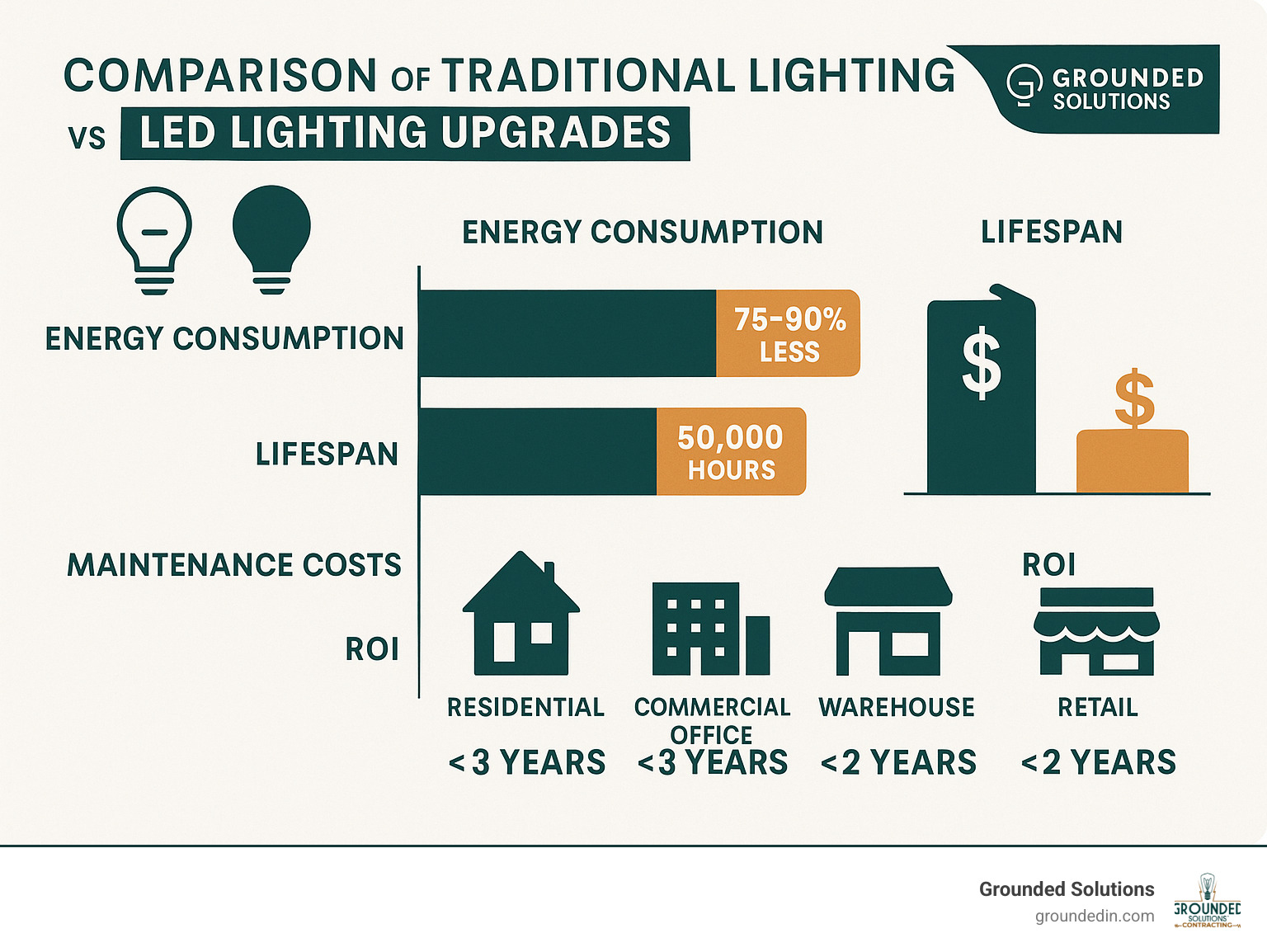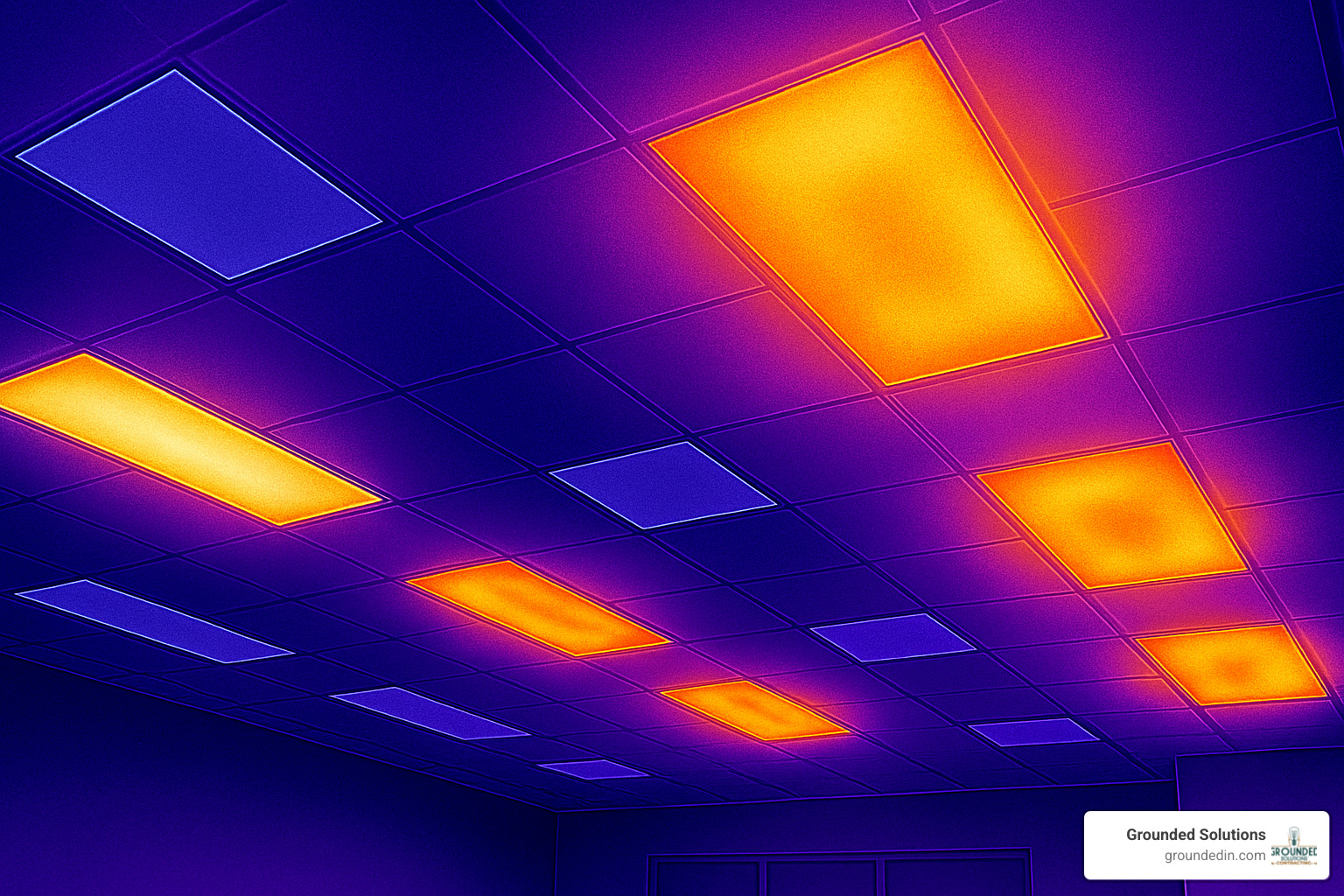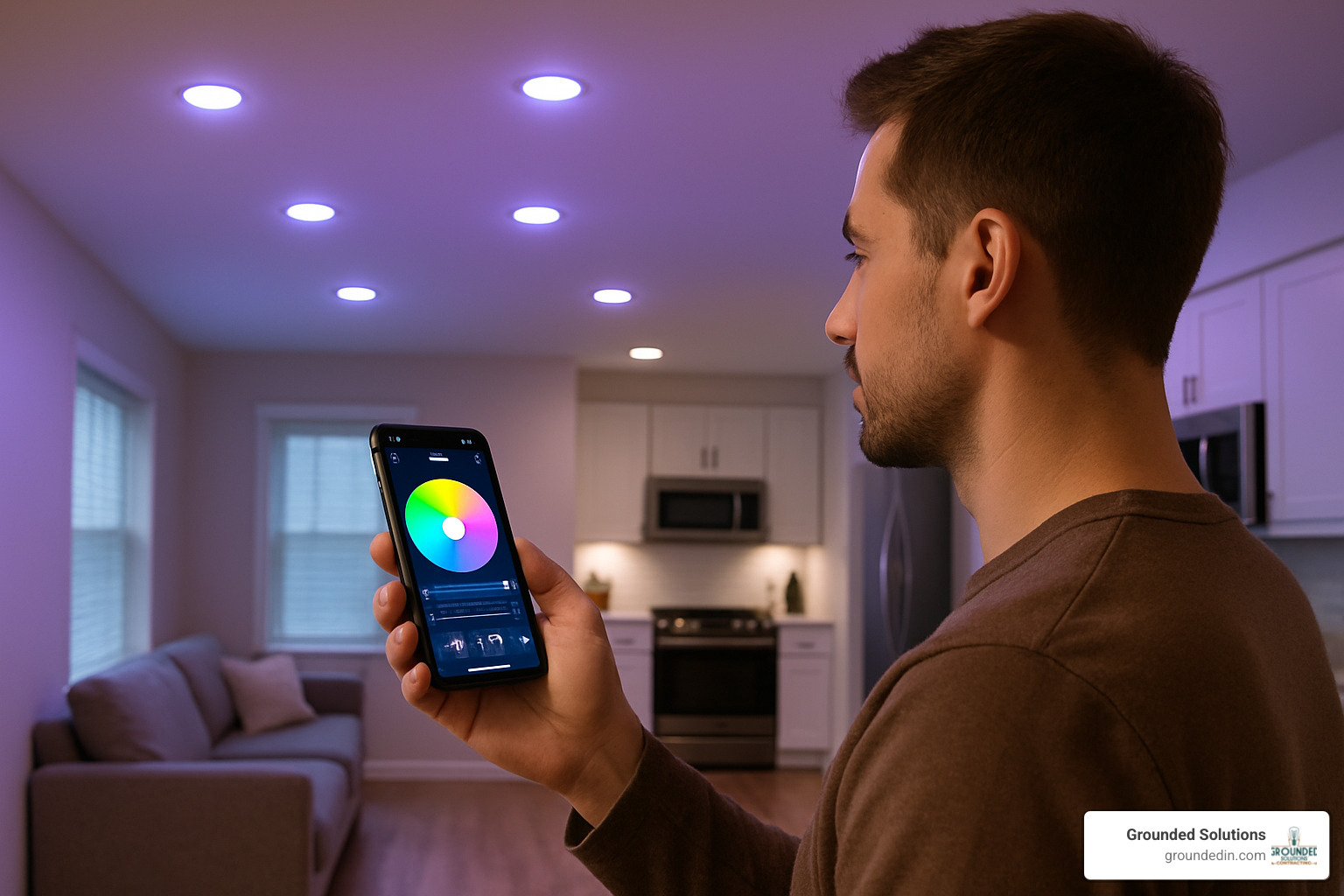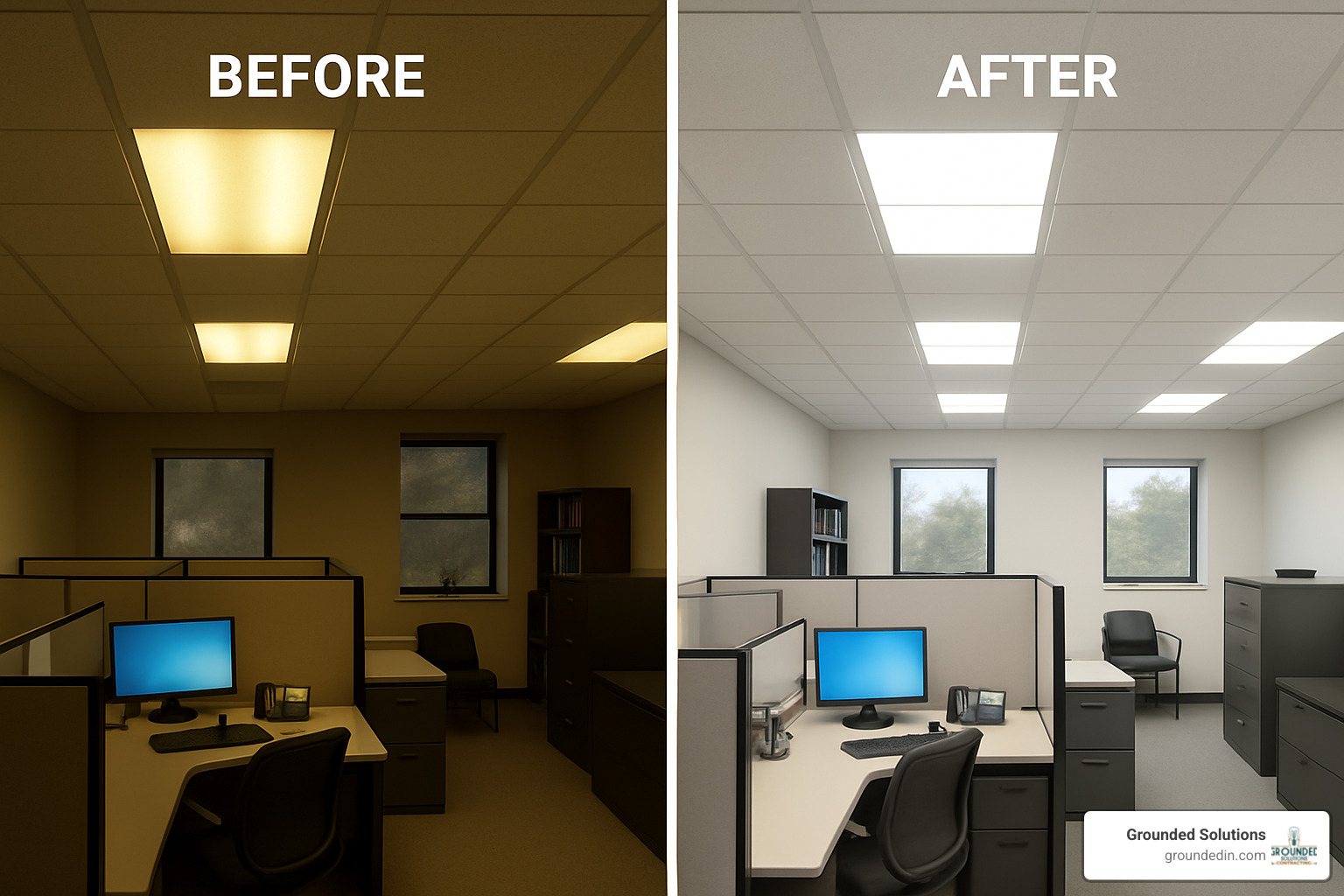The Bright Future of Energy Efficiency
LED lighting upgrades are cost-effective modifications that replace traditional lighting systems with energy-efficient LED technology. These upgrades can reduce energy consumption by 75-90% while providing better light quality and longer lifespans.
Key Benefits of LED Lighting Upgrades:
- Energy Savings: Use 75-90% less electricity than traditional lighting
- Extended Lifespan: Last up to 50,000 hours (25 times longer than incandescent bulbs)
- Lower Maintenance: Require fewer replacements and repairs
- Improved Light Quality: Provide consistent, flicker-free illumination
- Safety: Generate minimal heat, reducing fire risks
- Environmental Impact: Reduce carbon footprint and contain no mercury
The path to energy efficiency begins with lighting. When an electrician pointed out how many recessed lights we had in our facility and suggested LEDs to save money, I was skeptical about the upfront costs. However, the long-term savings have been undeniable. LED lighting is today’s most energy-efficient and rapidly developing lighting technology, offering dramatic reductions in both energy consumption and maintenance expenses.
By switching to LED lighting, you’re not just changing bulbs – you’re making a strategic investment in your property’s efficiency and sustainability. The Department of Energy estimates that by 2035, widespread use of LEDs could save 569 TWh of electricity annually in the U.S. alone – equivalent to the annual output of more than 92 1,000 MW power plants.
If your building relies on inefficient lighting such as incandescent, halogen, HID, or T12 fluorescent fixtures, you’re missing out on significant savings. An LED upgrade is more than a simple bulb replacement; it’s a comprehensive approach to improving your space while reducing costs.
I’m Clay Hamilton, President of Grounded Solutions, with over two decades of hands-on expertise in electrical systems and a passion for helping Indianapolis businesses and homeowners benefit from LED lighting upgrades that deliver measurable results and lasting value.

What Are LED Lighting Upgrades?
Ever wondered what exactly makes LED lighting upgrades so special? Simply put, they’re the process of swapping out your old-school lighting for Light Emitting Diode technology that’s smarter, more efficient, and longer-lasting.
Unlike those traditional incandescent bulbs that create light by heating a tiny wire until it glows (pretty inefficient, right?), or fluorescent tubes that use mercury vapor and gas, LEDs work through a fascinating semiconductor process that converts electricity directly into light—with barely any wasted energy.
“I installed LEDs throughout our warehouse last year, and honestly, I wish we’d done it sooner,” one of our Indianapolis clients told me recently. “The place is brighter, our electric bill dropped dramatically, and I haven’t had to replace a single bulb yet.”
When considering an LED lighting upgrade, you typically have three paths to choose from:
-
Relamp (Simple Replacement): This is the easiest approach—just swap your existing bulbs with LED versions that fit the same sockets. No electrician needed for many fixtures, making it perfect for DIY homeowners.
-
Retrofit: Here, we use special kits to modify your existing light fixtures to work with LED technology. It’s a middle-ground approach that keeps your current fixtures while updating the guts.
-
Full Fixture Replacement: For maximum performance, we remove old fixtures entirely and install new LED-designed fixtures. While this requires a bigger upfront investment, it delivers optimal light quality and efficiency.
What makes LEDs truly stand out is how they deliver light. Traditional bulbs waste energy by radiating light in all directions (much of which never reaches where you need it), while LEDs direct light precisely where it’s needed. Plus, they generate minimal heat—unlike incandescent bulbs that turn 90% of their energy into heat rather than light!
| Lighting Type | Energy Efficiency | Lifespan (hours) | Heat Output | Directional Light | Contains Mercury |
|---|---|---|---|---|---|
| Incandescent | Very Low | 1,000-2,000 | High | No | No |
| Halogen | Low | 2,000-4,000 | Very High | No | No |
| Fluorescent | Medium | 8,000-20,000 | Medium | No | Yes |
| HID | Medium-High | 10,000-24,000 | High | Partially | Yes |
| LED | Very High | 25,000-50,000+ | Very Low | Yes | No |
LED lighting upgrades in homes
For Indianapolis homeowners, LED lighting upgrades aren’t just about saving money—they’re about improving your daily life. With incredible lifespans reaching up to 50,000 hours, an LED bulb used for 3 hours each day could last over 45 years! Think about that—install them now, and you might never need to change some of these bulbs again.
One of my favorite features to show clients is the color temperature options. Want a cozy, warm glow in your living room? Choose warm white LEDs (2700-3000K). Need bright, clear light for detailed tasks in your kitchen or home office? Cool white options (4000-5000K) provide that crisp illumination that makes colors pop and reduces eye strain.
“I was skeptical about LEDs because I remember those harsh blue lights from years ago,” a Carmel homeowner told us after her upgrade. “But these new ones are beautiful—and I love being able to dim them for movie nights!”
That’s another big advantage—most modern LEDs work beautifully with dimmer switches (though it’s always smart to check compatibility). For homes with recessed can lights, LED retrofit kits transform those energy-hungry fixtures into efficient lighting without major construction or ceiling modifications.
LED lighting upgrades in commercial buildings
For Indianapolis businesses, the case for LED lighting upgrades is even more compelling. Did you know lighting gobbles up about 17% of all electricity used in U.S. commercial buildings? With longer operating hours than homes, those energy savings multiply quickly.
I recently helped a local warehouse replace their high-bay HID fixtures with LED equivalents. We reduced their lighting power density from 3 watts per square foot to just 1 watt while actually improving visibility on the floor. For a 100,000-square-foot facility, that kind of reduction translates to over $100,000 in annual energy savings—not counting the reduced maintenance costs.
Commercial upgrades often involve bypassing or removing the ballasts used in fluorescent systems. This eliminates an additional point of failure and further boosts efficiency. We can also integrate your new LEDs with building automation systems, enabling smart controls that maximize savings through occupancy sensing and daylight harvesting.
“Our office building’s hallways used to stay lit 24/7,” explained the property manager of a Fishers office complex. “Now with LED fixtures and motion sensors, they’re only at full brightness when someone’s present. Our first-year ROI was 56%—better than most of our other investments!”
The technical side of commercial LED upgrades involves understanding ballast bypass procedures for fluorescent replacements and ensuring proper light distribution for specific work environments. At Grounded Solutions, we handle these complexities so you don’t have to worry about the technical details—just enjoy the improved lighting and lower utility bills.
LED Lighting Upgrades: Benefits & Real Savings
The magic of LED lighting upgrades goes far beyond simply swapping out old bulbs. When you make the switch, you’re open uping a whole package of benefits that transform both your space and your bottom line.

Let’s talk real numbers. LED lighting upgrades typically slash energy consumption by a whopping 75-90% compared to traditional lighting. This dramatic drop comes not just from LED’s inherent efficiency, but also from its smart directional design that puts light exactly where you need it without wasteful scatter.
I recently worked with a commercial client who converted 2,000 fluorescent fixtures in their office building. Their lighting load plummeted from 192 kW to just 80 kW—a 58% reduction! But here’s the bonus they weren’t expecting: because LEDs run so much cooler than traditional lighting, their air conditioning system didn’t have to work as hard, saving an additional 28 kW in cooling costs. That’s the kind of ripple effect that makes LED lighting upgrades so powerful.
The maintenance savings are just as impressive. LEDs last up to 25 times longer than incandescent bulbs and 3-5 times longer than fluorescent tubes. For one of our warehouse clients with high ceilings, this benefit alone justified the upgrade—no more frequent bulb changes requiring expensive lift rentals and staff time.
As one of our clients put it: “I was skeptical about spending more upfront on LEDs, but when I realized I wouldn’t be climbing ladders to change bulbs every few months, I was sold!”
Safety improvements are another key benefit that often gets overlooked. LEDs operate at much lower temperatures than traditional lighting, significantly reducing fire risks and burn hazards. They also restart instantly after power outages, unlike those frustrating HID lamps that need a cool-down period before coming back on.
Most of our Indianapolis clients see a return on investment (ROI) for their LED lighting upgrades within 3-5 years, though many projects hit payback in under 2 years when utility incentives are applied. This represents one of the fastest returns of any building improvement project you can make.
Energy & cost math that matters
Understanding the financial impact of your potential LED lighting upgrade is easier than you might think. Here’s a quick comparison that shows the dramatic difference in energy use:
| Original Fixture | Wattage | LED Replacement | Wattage | Energy Savings |
|---|---|---|---|---|
| Incandescent 60W | 60W | LED Equivalent | 9W | 85% |
| Halogen 50W | 50W | LED Equivalent | 9W | 82% |
| T8 Fluorescent | 32W | LED Tube | 15W | 53% |
| Metal Halide | 450W | LED High Bay | 150W | 66% |
When we sit down with our Indianapolis clients to calculate their potential savings, we start by establishing their current lighting energy baseline. We count fixtures, multiply by operating hours and days per year, then factor in their electricity rate. Then we run the same calculation with the reduced LED wattage to show the annual savings. The results are often eye-opening.
Many of our commercial clients achieve a 56% average first-year return on investment. One recent project in central Indiana involved a $150,000 investment in LEDs for a 100,000-square-foot facility. The combination of energy savings, reduced maintenance costs, and improved productivity yielded approximately $300,000 in annual benefits—paying for itself in just six months!
Environmental and health perks
The green benefits of LED lighting upgrades extend far beyond your utility bill. Unlike fluorescent and HID lighting, LEDs contain zero mercury, eliminating those pesky hazardous waste concerns and special disposal requirements.
The reduced energy consumption directly translates to a smaller carbon footprint. According to the Department of Energy, widespread LED adoption could reduce annual carbon emissions by 160 million metric tons by 2035—equivalent to taking 28 million cars off the road!
But perhaps the most underrated benefits are the ones you feel every day. Quality LED fixtures provide flicker-free illumination that reduces eye strain and those afternoon headaches commonly associated with fluorescent lighting. Modern LEDs can deliver excellent color rendering (CRI >90), making colors appear natural and vibrant.
One of our Indianapolis office clients reported that after their LED lighting upgrade, employee complaints about headaches and eye fatigue dropped dramatically. “The light feels more natural,” one employee commented. “I don’t get that mid-afternoon exhaustion anymore.”
Another client who manages a retail space noticed customers spending more time in the store after their lighting upgrade. “The products look better, the space feels more inviting, and people linger longer,” she explained.

The beauty of LED lighting upgrades is that they deliver benefits on so many fronts simultaneously: financial savings, environmental improvements, and improved comfort. As you consider upgrading your Indianapolis home or business, retrofit benefits extend far beyond the immediate energy savings—they’re an investment in your space’s long-term comfort, productivity, and sustainability.
Selecting Your Upgrade Path & Process
Choosing the right approach for your LED lighting upgrade depends on several factors, including your budget, existing infrastructure, and performance goals. Let’s examine the three main upgrade paths:
1. Relamp (Screw-in Replacement)
- Best for: Quick, low-cost upgrades with minimal disruption
- Process: Simply replace existing bulbs with LED equivalents
- Advantages: No rewiring, lowest upfront cost, DIY-friendly
- Limitations: May not optimize energy savings, limited fixture options
2. Retrofit Kit
- Best for: Balancing cost and performance when existing fixtures are in good condition
- Process: Remove old components (bulbs, ballasts) and install LED modules in existing housings
- Advantages: Preserves existing fixtures, better performance than simple relamping
- Limitations: Requires some electrical work, may need professional installation
3. Full Fixture Replacement
- Best for: Maximum performance and long-term savings
- Process: Remove old fixtures entirely and install new LED-optimized fixtures
- Advantages: Optimal light distribution, maximum efficiency, newest features
- Limitations: Highest upfront cost, most disruptive installation
A typical LED lighting upgrade project follows these phases:
- Audit: Assess current lighting system, energy use, and needs
- Design: Select appropriate LED solutions and develop implementation plan
- Installation: Remove old components/fixtures and install new LED equipment
- Commissioning: Test and adjust the new system for optimal performance
“At Grounded Solutions, we’ve found that the most successful LED upgrades start with a thorough assessment of the existing conditions and client goals,” explains our lead electrician. “This ensures we’re providing the right solution rather than just swapping out bulbs.”
Step-by-step roadmap
For a successful LED lighting upgrade, follow this detailed roadmap:
-
Assessment:
- Inventory all existing fixtures (type, wattage, quantity)
- Measure current light levels using a light meter
- Identify problem areas (too dim, too bright, uneven lighting)
- Document operating hours for each area
-
Baseline Measurement:
- Calculate current energy consumption and costs
- Review maintenance records and replacement frequency
- Establish performance metrics for comparison after upgrade
-
Product Selection:
- Choose appropriate color temperature (2700K-3000K for residential/hospitality, 3500K-4000K for offices, 5000K for task-oriented spaces)
- Verify lumen output meets or exceeds existing levels
- Select fixtures with appropriate beam angles and distribution patterns
- Confirm dimming compatibility if needed
-
Professional Installation:
- Hire licensed electricians for complex retrofits or new fixtures
- Ensure proper disposal of old fixtures (especially fluorescents)
- Install according to manufacturer specifications
- Update electrical panels if load changes significantly
-
Post-Monitoring:
- Measure new light levels to verify improvement
- Track energy consumption to confirm savings
- Document maintenance reductions
- Make adjustments as needed for optimal performance
“Measuring baseline performance establishes a clear reference point to gauge retrofit success,” notes one energy consultant. This data-driven approach ensures you can quantify the actual benefits of your LED lighting upgrade.
DIY vs. pro help
While simple relamping projects can be DIY-friendly, many LED lighting upgrades benefit from professional expertise. Consider these factors when deciding between DIY and professional installation:
DIY may be appropriate when:
- You’re simply replacing bulbs with LED equivalents
- Fixtures are easily accessible (no high ceilings or complex systems)
- No rewiring or electrical modifications are needed
- You’re comfortable working with basic electrical components
“For accessible fixtures, DIY retrofit kits are possible, but for extensive work or installations at height, hiring a professional is recommended,” advises one lighting specialist.
Professional installation is recommended when:
- Retrofitting involves ballast bypass or rewiring
- Installing new fixtures requires electrical modifications
- Working with high ceilings or complex lighting systems
- Integrating controls or sensors
- Warranty preservation is important (many manufacturers require professional installation)
At Grounded Solutions, our licensed electricians have extensive experience with LED lighting upgrades throughout central Indiana. We ensure safe, code-compliant installations that maximize energy savings and light quality. Our professionals can also help steer rebate programs and incentives that may not be available for DIY installations.
“We had to return our first purchase because the fixture was too deep for our recessed cans,” shared one homeowner who attempted a DIY upgrade. “A professional would have known to measure the housing depth before ordering.”
Planning for Success: Controls, Incentives, Compliance
To maximize the benefits of your LED lighting upgrade, consider incorporating advanced controls, taking advantage of available incentives, and ensuring code compliance.

I remember visiting a client’s office space after we installed their new LED system with smart controls. When I demonstrated how they could adjust their lighting from their phone, their eyes lit up brighter than the fixtures! That moment perfectly captures why modern lighting isn’t just about the bulbs—it’s about creating an intelligent system that works for you.
Smart lighting controls can boost your energy savings by an additional 30-50% beyond the basic LED upgrade alone. Think about it: even the most efficient light wastes energy when illuminating an empty room. That’s where occupancy sensors come in, automatically turning lights off in unoccupied spaces. Daylight harvesting systems are equally impressive, dimming artificial lighting when natural light streams through windows—why pay for light when the sun provides it for free?
“LED fixtures with controllers connected to a building management system enable precise control and automation, especially in intermittent occupancy or high-demand spaces,” explains one building automation specialist I work with regularly.
For Indianapolis businesses, staying ahead of energy codes isn’t just good practice—it’s increasingly necessary. New construction and major renovations must comply with standards that often mandate LED lighting and controls. Key regulations include ASHRAE 90.1-2022, which sets minimum energy efficiency standards, the Indiana Energy Conservation Code with its state-specific modifications, and various local ordinances that might apply to your property.
As one regulatory expert recently told me, “Commercial buildings exceeding 25,000 square feet must comply with updated energy codes by 2025 in many jurisdictions.” Getting ahead of these requirements through proactive LED lighting upgrades now can prevent scrambling to meet compliance deadlines later—and you’ll be saving money the entire time.
Advanced controls amplify LED lighting upgrades
When we installed task-tuning controls at a local law office, the managing partner called me a week later amazed at how much more comfortable their workspace felt. “The lighting adjusts to what we’re doing instead of us adjusting to the lighting,” she said. That’s the magic of advanced lighting controls—they create truly responsive environments.
Occupancy sensing technology has come a long way from those frustrating motion sensors that would leave you waving your arms frantically in bathroom stalls. Today’s sophisticated systems use multiple detection methods (PIR, ultrasonic, or dual-technology) to accurately detect presence, reducing lighting energy use by 20-60% in appropriate spaces without any inconvenience.
Daylight harvesting is particularly effective in our sunny Indiana summers. Using photosensors to measure available natural light, these systems automatically dim artificial lighting to maintain consistent levels. They’re most effective in perimeter spaces with windows or skylights and can reduce lighting energy use by 20-40% in daylit areas.
The real game-changer, though, is IoT integration. By connecting your lighting to broader building management systems, you’re not just controlling lights—you’re collecting valuable data on space utilization and energy use. This enables predictive maintenance based on fixture performance and creates opportunities for demand response programs with utilities, potentially generating additional savings or even revenue.
As one facility manager told me after we completed their system, “By installing LED fixtures with networked controls, we can automatically adjust lighting for intermittent occupancy and high-demand areas.” Their building saw an additional 30% savings after adding controls to an already efficient LED system—nearly doubling their initial energy reduction.
Funding the switch
“I love the idea of upgrading to LEDs, but the upfront cost…” I hear this concern almost daily, and I’m always happy to share some good news: you have options! The initial investment in LED lighting upgrades can be significantly offset through various incentives and financing solutions.
Utility rebates are the low-hanging fruit of LED financing. Many utilities offer substantial rebates that can reach up to $249 per fixture for commercial applications. Look for “instant rebates” that reduce the purchase price at the time of sale—they’re like getting a discount without the paperwork hassle. Just remember that DLC (DesignLights Consortium) certification is often required for eligibility, something we always verify before recommending products.
Tax incentives can further sweeten the deal. Federal tax deductions may be available through the Energy Efficient Commercial Buildings Deduction (Section 179D), and accelerated depreciation for energy-efficient building improvements can improve cash flow. State and local tax incentives vary by location, and we help our clients steer these opportunities regularly.
For businesses wanting to avoid upfront costs entirely, innovative financing options have transformed how LED lighting upgrades can be implemented. Energy-as-a-Service (EaaS) models allow for no upfront cost, while Property Assessed Clean Energy (PACE) financing ties repayment to property tax assessments. On-bill financing through utilities spreads costs over monthly utility bills, and performance contracting guarantees energy savings will cover financing costs.
As one financing specialist put it, “Through the Energy as a Service solution, financial, technical, and logistical barriers are removed to make the retrofit easy, affordable, and risk-free.”
At Grounded Solutions, we help our Indianapolis-area clients steer these incentive programs to maximize their return on investment. Many of our commercial clients achieve payback periods of less than two years when combining energy savings with available incentives. It’s tremendously satisfying to show clients how they can transform their lighting—and their bottom line—with minimal out-of-pocket expense.
Want to learn more about LED lighting retrofits specific to Indianapolis? Check out our detailed guide on LED Lighting Retrofit in Indianapolis: Save Energy & Money.
FAQs & Common Pitfalls about LED Lighting Upgrades
What factors determine payback time?
When clients ask me about the return on their investment in LED lighting upgrades, I always explain that several key factors influence how quickly they’ll recoup their costs.
The hours your lights stay on is perhaps the most significant factor. Think about it – a warehouse running lights 24/7 will see savings accumulate much faster than an office used only during business hours. That’s why facilities like hospitals, manufacturing plants, and parking garages typically achieve the fastest payback periods.
Your local electricity rates play a crucial role too. Here in Indiana, our commercial rates currently run below the national average, but most of our business clients still achieve impressive 2-3 year paybacks. The higher your electricity costs, the quicker you’ll see returns.
What you’re replacing matters tremendously. I remember one client who was shocked at their one-year payback after replacing old halogen track lighting with LEDs. The contrast between inefficient incandescent or halogen lighting versus LEDs creates dramatic savings compared to upgrading from already somewhat efficient T8 fluorescents.
“We replaced our showroom halogens with LEDs and our utility bill dropped so dramatically that our accountant called to make sure there wasn’t a billing error,” one Indianapolis retailer told me with a laugh.
Don’t overlook available incentives! Utility rebates and tax incentives can slash payback periods significantly – sometimes to less than a year for qualifying projects. At Grounded Solutions, we help our clients steer these opportunities to maximize their returns.
Will my existing dimmers work with LEDs?
Dimmer compatibility is one of the most common concerns I hear when discussing LED lighting upgrades with homeowners and business owners alike.
Most existing residential dimmers are what we call “triac” or phase-cut dimmers, originally designed for incandescent bulbs. While many LED products now work with these dimmers, compatibility isn’t universal. I always advise clients to look specifically for “dimmable” on LED packaging and check manufacturer compatibility lists before making a purchase.
Commercial applications often require different approaches. Some LED fixtures need specialized 0-10V dimming systems rather than traditional dimmers. This is particularly true for larger installations where precise light control is important.
I’ve seen plenty of situations where older dimmers cause LEDs to flicker or buzz – an annoying issue that can quickly sour the LED experience. Another common problem occurs when low-wattage LEDs don’t meet the minimum load requirements of older dimmers.
“When we first installed LEDs in our conference room, the lights flickered terribly until we replaced the old dimmer switch,” shared one Indianapolis business owner. “The new LED-rated dimmer solved the problem completely.”
For residential projects with existing dimmers, we typically recommend testing a single LED bulb before converting an entire space. For commercial applications, we often suggest upgrading to modern dimming systems that offer smoother performance and additional features like scene setting and building automation integration.
How do I avoid common retrofit mistakes?
After overseeing hundreds of LED lighting upgrades across central Indiana, I’ve noticed some recurring pitfalls that even well-intentioned projects can encounter.
Ballast compatibility issues cause frequent headaches. Some LED tubes are designed to work with existing fluorescent ballasts, while others require ballast bypass (direct wiring). Mixing these approaches in the same facility creates maintenance confusion and potential safety hazards. We always recommend choosing one approach consistently and clearly labeling modified fixtures.
Color temperature inconsistency is immediately noticeable but often overlooked during planning. Walking through a space with mixed 3000K and 4000K LEDs creates an uneven, patchwork appearance that looks unprofessional. I advise standardizing on one color temperature per space – typically 3000K for residential and hospitality, 3500-4000K for offices, and 4000-5000K for task-oriented environments.
I recently visited a retail store where half the space had warm white LEDs and half had cool white. The owner hadn’t realized the importance of consistency when ordering replacement bulbs in batches.
Insufficient light levels disappoint many first-time LED adopters who focus solely on wattage. Since LEDs use less energy, wattage is no longer a reliable indicator of brightness. We train our clients to focus on lumen output instead when selecting replacements. A 9-watt LED might replace a 60-watt incandescent, but only if it delivers the same 800 lumens.
Ignoring controls potential leaves significant savings on the table. Simply replacing bulbs without adding sensors or dimming capabilities misses up to 30-50% of possible energy savings. Even simple occupancy sensors in bathrooms, storage areas, and conference rooms can dramatically boost the return on your LED lighting upgrade.
Poor product quality leads to premature failures and performance issues. We’ve had clients come to us after DIY installations with bargain LEDs started failing within months. For lasting results, we recommend ENERGY STAR certified products for homes or DLC-listed products for commercial applications.
At Grounded Solutions, our professional electricians help Indianapolis clients avoid these common pitfalls through thorough assessments before recommending specific LED lighting upgrade solutions. We believe in doing the job right the first time – it saves everyone headaches down the road.

Conclusion
Embracing LED lighting upgrades isn’t just about changing bulbs—it’s about changing your space while making a smart investment in your future. Here in central Indiana, we’ve seen how these upgrades create brighter, more comfortable environments while dramatically reducing energy costs by 75-90%. The numbers tell a compelling story, but the real magic happens when you experience the improved quality of light and the satisfaction of lower utility bills month after month.
“I never realized how much of a difference lighting could make until we upgraded,” shared one Indianapolis business owner. “Not only are we saving thousands annually, but our employees actually comment on how much better the workspace feels.”
The journey to better lighting doesn’t have to be complicated. Whether you’re considering a simple bulb replacement in your home or planning a comprehensive retrofit for your commercial building, the path forward is clear and the benefits substantial. With professional guidance, your LED lighting upgrade can deliver improved visual comfort, remarkable energy savings, and virtually eliminated maintenance headaches for years to come.
The environmental impact of making the switch extends far beyond your property lines. Each LED lighting upgrade contributes to a significant reduction in carbon emissions. When you consider that widespread LED adoption could eliminate 160 million metric tons of carbon emissions annually by 2035—equivalent to removing 28 million cars from our roads—the collective impact becomes truly inspiring.
At Grounded Solutions, we take pride in guiding Indianapolis families and businesses through their lighting change journeys. As a local, family-owned electrical contractor deeply rooted in our community, we understand the unique needs and challenges of central Indiana properties. Our team of licensed, bonded, and insured electricians brings both technical expertise and genuine care to every project, ensuring your LED lighting upgrade is handled with precision from initial assessment through final installation.
We believe in creating partnerships, not just completing projects. That’s why we take the time to understand your specific goals, explain your options in plain language, and develop solutions that align with your priorities and budget. Whether you’re upgrading a single room in your home or retrofitting an entire commercial facility, our approach remains the same: thoughtful, thorough, and focused on delivering lasting value.
The future of energy efficiency is bright—and it starts with the decision to upgrade your lighting. By partnering with Grounded Solutions, you’re not just getting new lights; you’re gaining a trusted advisor committed to helping you create spaces that are more efficient, more comfortable, and more sustainable.
Let’s illuminate your path to exceptional lighting that saves energy, reduces costs, and improves your space. Your brighter future is just a conversation away.




